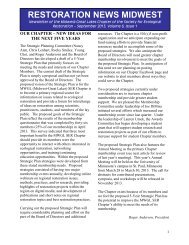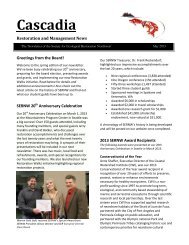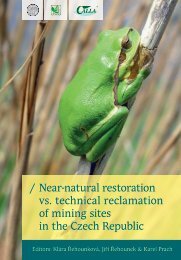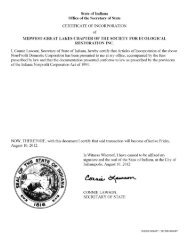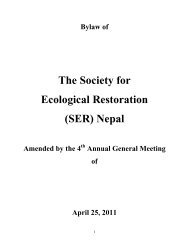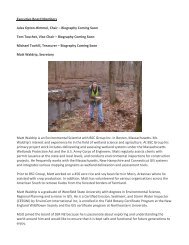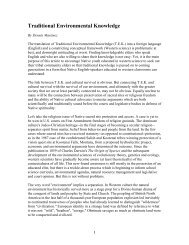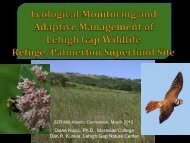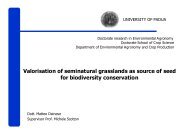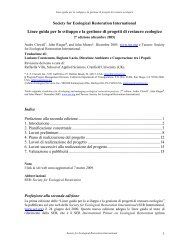THE WORLD CONFERENCE ON ECOLOGICAL RESTORATION
A Global Challenge - Society for Ecological Restoration
A Global Challenge - Society for Ecological Restoration
Create successful ePaper yourself
Turn your PDF publications into a flip-book with our unique Google optimized e-Paper software.
2005 The World Conference on Ecological Restoration 27<br />
The Community-Owned Forest of Arcata, California: A Model of Sustainable<br />
Redwood Forest Restoration<br />
Andre, M.<br />
Environmental Services, City of Arcata, California<br />
The Arcata Community Forest established in 1955, comprises 803 hectares of 100-120 year old second<br />
growth redwood forest in Humboldt County California. Community Forests are relatively rare in the western<br />
United States, but recently there has been an increasing interest and effort to establish community<br />
forests in many areas. The City of Arcata government leaders and its citizen’s are committed to a sustainable<br />
management program that serves as a model of a managed redwood forest for demonstration<br />
and educational purposes. Timber harvest revenue funds forest operations and open space and parkland<br />
acquisitions. During the past 25 years, various silvicultural systems including variable retention, group<br />
selection, group selection with green tree retention and single-tree selection has attempted to mimic natural<br />
disturbance regimes such as wind throw and low intensity fire. The goal of providing habitat for<br />
species associated with late-successional forest habitat in second growth redwood forests has primarily<br />
focused on retaining structural elements while creating multi-aged stands, increased species diversity<br />
and introducing “chaos” into relatively even aged 120-year-old stands. An array of permanent plots is<br />
used to monitor changes in understory vegetation, structural features such as logs and snags, invasive<br />
species, lichens, bryophytes and liverworts. Plot data is compared to reference stands including small adjacent<br />
patches as well as larger old growth forest areas in nearby Redwood National Park. Arcata’s adaptive<br />
management approach to increase biodiversity, accelerate old forest conditions, provide late successional<br />
forest habitat while providing revenue is a long-term project that provides a valuable case study<br />
for the region as efforts to restore redwood forests are expanded.<br />
Keywords: Redwood, sustainability, restoration, community forestry.<br />
The effect of Acacia saligna and dune stabilization on rodent populations in<br />
Ashdod-Nitzanim sands<br />
Anglister 1 N, U. Motro 2 , Y. Yom-Tov 1<br />
1 Department of Zoology, Tel-Aviv University, Tel-Aviv, 69978<br />
2 Department of Evolution, Systematics and Ecology, The Hebrew University of Jerusalem, Jerusalem 91904<br />
The coastal dune habitat of Israel is diminishing rapidly, mostly due to massive urbanization, fragmentation<br />
and changes of habitat characteristics caused by dune stabilization and the introduction of Acacia<br />
saligna, an invasive species brought to Israel for the purpose of dune stabilization. We studied the effect<br />
of sand stabilization, on the populations of small mammals. The research was conducted from April 2003<br />
through April 2004 in the Ashdod-Nizzanim sands; it included a total of 58 trapping nights. We analyzed<br />
differences in species diversity, abundance and body condition of each species of rodent in four plots:<br />
Unstablized dunes, semi-stablized dunes, stablized dunes and one plot with the presence of Acacia<br />
saligna. Gerbillus pyramidum and Jaculus jaculus were captured almost entirely on the unstabilized<br />
dunes. Gerbillus andersoni allenbyi was captured mostly on the semi-stabilized plot. On the other hand,<br />
human commensals such as Mus musculus were found only on the stabilized dunes and on the Acacia<br />
plot. Cluster analysis of species similarity among the four plots places the very similar stabilized and<br />
semi-stabilized plots in the same cluster with the Acacia plot wheras the unstabilized plot forms another,<br />
distinct cluster. The results of this research show that dune stabilization is followed by changes in rodents<br />
populations - the disappearance of psammophile rodents and the appearance of human commensals.<br />
Measures should be taken to stop the spread of the Acacia and the continuing stabilization of the<br />
sands in order to conserve the psammophile species.<br />
Keywords: dune stabilization, Acacia saligna, rodents.



